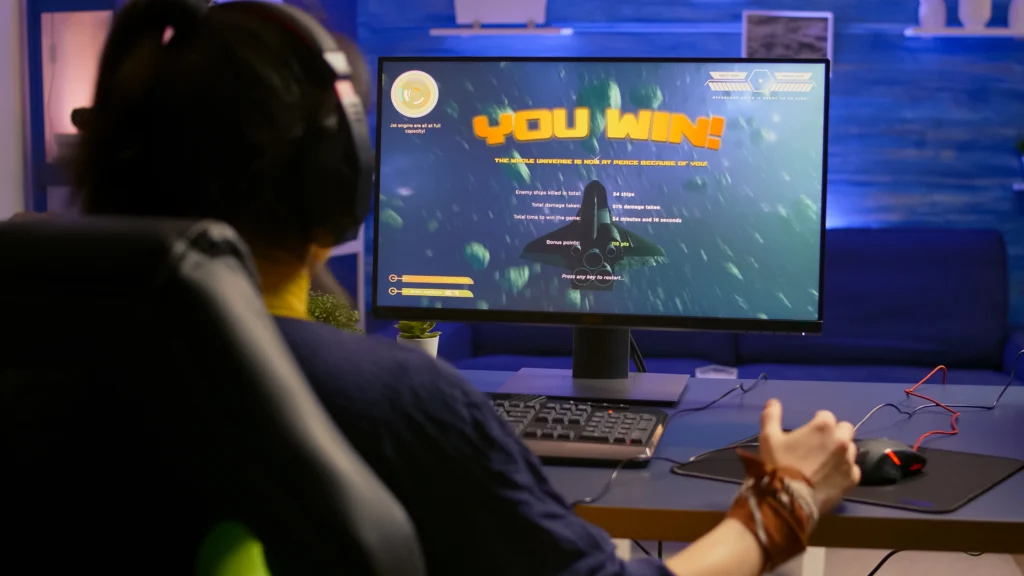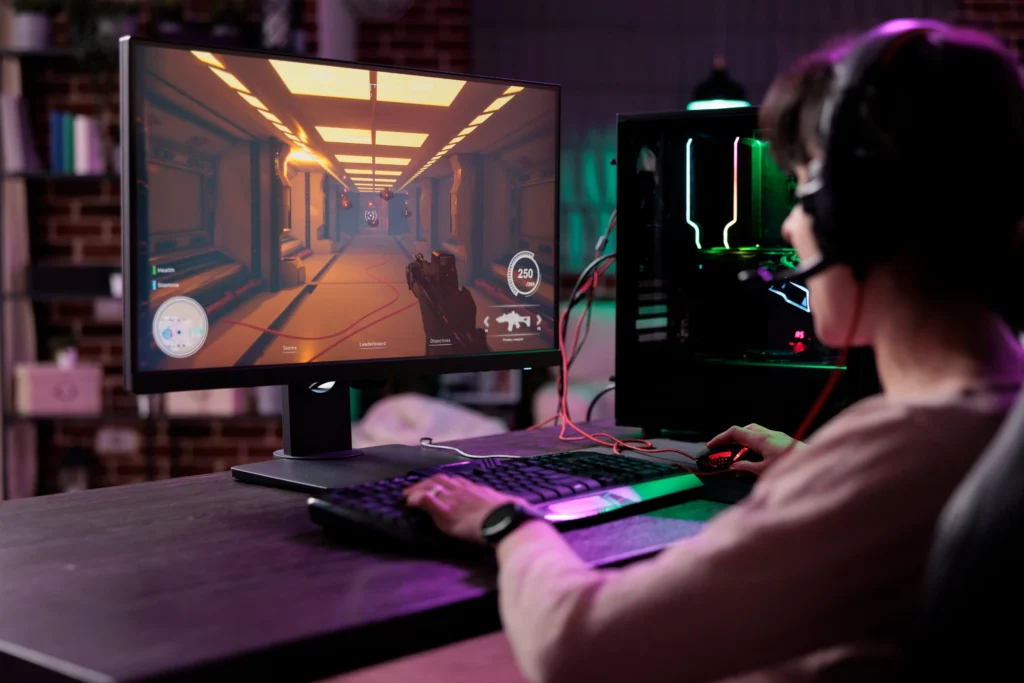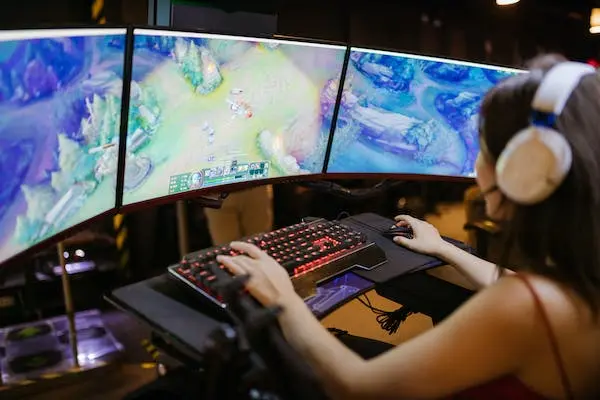How to Make an IO Game? – A Comprehensive Guide

Table of Contents
Introduction
Welcome to .io games, where millions of players enjoy accessible and fun games worldwide. Whether it’s the simple yet addictive Agar.io or the battle arena of Slither.io, these online multiplayer games have cemented their legacy. With their straightforward mechanics and competitive gameplay, they effortlessly hook gamers.
If you’re wondering how to create your own io game, this comprehensive guide is for you. We’ll explore making a game from conceptualizing to building, design to deployment. Whether you’re a beginner or a seasoned developer, this resource-style post not only teaches you how to make io games but brings you through the entire creation process.
Let’s get started exploring the world of .io game development and discover how you can transform a simple idea into a global online gaming experience.
Exploring the .io Phenomenon
Definition and Characteristics of .io Games
In the growing world of online gaming, .io games have carved out a unique niche. These games are not only simple and inclusive, but they can also be deeply addictive games. They are multiplayer browser-based games that offer both casual gamers and dedicated players alike a fun experience, without requiring any downloads or installations. So what sets a .io game apart? It all stems from their lightweight, accessible, and social nature.
So what are .io games? They are simple, inclusive and addictive games. They are single or multiplayer browser-based games that offer both casual gamers and dedicated players a challenge by allowing anyone to access through a browser, so there’s no need for any downloads or installations. What makes .io games special? They are easily accessible and lightweight, playable on older computers and mobile devices. Game developers often look at making minimalist games that are easy to onboard users, and may include multiplayer features to create a more social experience and retain a diverse player base on a global scale.
Popularity Among Gamers and Developers
The mass appeal of .io games stems from their intuitive, pick-up-and-play ethos, where anyone, regardless of their gaming experience, can dive into the action right away. Players can expect games that are easy to pick up, yet these games can have unassuming complexity and camaraderie (or rivalry!) from multiplayer games. These result in entertaining, bite-sized gameplay sessions. From a developer’s viewpoint, these games have mass appeal, and straightforward development and maintenance processes. This straightforward nature offers a less resource-intensive way to build games, creating a fertile ground for experimentation and innovation without diving too deep into intricate coding processes.
The .io Blueprint: Simple and Engaging
When it comes to creating successful and fun .io games, it’s important to understand the defining characteristics. These games prioritize a seamless user experience, from the moment players land on the website to entering the game. There should be minimal requirements to get started, like signing up and requiring a nickname. Simplicity is key. Game mechanics and design should be easy to understand at a glance, with clear visuals and controls that engage players immediately. Moreover, if the game is multiplayer-based, they should incorporate social and competitive elements, offering real-time player interactions, leaderboards, or even cooperative mechanisms that encourage working together with others. At a high level, .io games combine straightforward design with compelling gameplay for a global audience.
Stepping into Game Development
Understanding the Basics of Game Development
There are limitless possibilities to building a game, but mastering the fundamentals is crucial. Before diving into creating an io game, let’s first understand the fundamentals of game development
Every game, whether it’s a complex RPG or a simple .io game, starts with a core idea. This core idea evolves into mechanics, narratives, and design elements that blend together to create an immersive player experience. For beginners, it may be difficult to think about all the elements together. However, by breaking game development down into the essential components – from ideation and design to coding and testing – you can begin building your games.
Choosing the Game Idea
The foundation of any good .io game lies in its core concept. When considering how to create io games, it is important to remember that simple is better. At the same time, you want to have a distinctive element that sets your game apart from the multitude of other .io games. Aspiring developers should brainstorm ideas that resonate with the audience: intuitive mechanics, an interesting premise, and whether it is multiplayer or single player. Remember, it isn’t about reinventing the wheel; rather, you want to refine your idea with unique touches. Drawing inspiration from existing .io games can help point you in a clear direction. Remember: Your goal is to capture players from the first click and keep them engaged and repeatedly coming back.
Deciding on the Game Mechanics
The game’s mechanics serve as the foundation for creating io games that captivate players and provide a good gaming experience. While .io games are known for their simplicity, their mechanics can vary from very basic gameplay, such as absorbing smaller entities (like in ‘Agar.io’), to more complex movements and strategic gameplay. The key is to ensure that these mechanics are easy to grasp but have some level of mastery needed to challenge more advanced players. Striking this delicate balance keeps players engaged, motivating them to improve their skills with each play. Moreover, the game mechanics should support and enhance the game whether it is for single player or multiplayer games. This fosters replayability as players strive to compete or cooperate with one another.
Choosing the Right Development Tools
Past just the game itself, developers also need to make sure they select the right set of tools for the project. Especially when creating an io game, the choice of development tools can greatly impact the end game. There are a multitude of platforms and frameworks available, but it’s important to select ones that cater to the demands of .io games.
Because io games are browser-based, tools like HTML5, JavaScript, and WebSocket are important considerations to use. Also, consider whether you plan to make a 2D or 3D game, as different frameworks may make it easier for development. And if you are not proficient in a programming language, there are several no-code game engines that are available for use. When diving into io game development, it’s crucial to ensure that the tools you choose not only align with your game’s technical requirements, but are also ones that you feel comfortable using or are willing to invest time in learning.
The Role of Server-Side Development
.io games are often multiplayer experiences, which require robust server-side development. When creating an io game, it’s important to understand that while the game runs on the player’s browser, it engages in real-time communication with a server that tracks every movement, interaction, and score. There are many options in developing server-side logic for .io games, for example, you could use a popular tool like Node.js and pair it with WebSocket. This ensures smooth exchange of data, which enables real-time player interactions like those in .io games. It’s also crucial to incorporate efficient netcode, which is responsible for smooth online interactions with a lag-free experience, especially important when players are entering games from around the world.
Game Optimization and Performance
Since io games are browser-based, performance optimization is crucial. Players expect a seamless, lag-free experience regardless of their device or browser. The appeal of io games is in their accessibility, and optimization is important to ensure that this is possible. Developers must prioritize reducing file sizes, optimizing graphics, and building efficient code to maintain smooth frame rates. Tools like Chrome DevTools can be invaluable for monitoring and improving performance. A game that loads quickly and runs seamlessly has a higher chance of retaining players and fostering a loyal community.
Ensuring Cross-Platform Compatibility
io games must have cross-platform compatibility to effectively bring in an audience. Players will access games from various devices and browsers, so it’s important to provide a consistent gaming experience. It can be challenging to accommodate multiplayer platforms, as factors like screen resolutions and touch controls and browser quirks can all affect gameplay, but it’s necessary in order to reach a wider audience. Developers should regularly test on different devices, and leverage tools like BrowserStack or LambdaTest, to help identify and address compatibility issues. This way every player, regardless of whether they are on desktop or mobile, can fully enjoy the game.
Designing for Engagement and Retention
Making Visually Appealing Graphics
It’s important to consider the visuals when creating an io game. While .io games may be known for their simplicity, designs can be quite advanced. Players enjoy minimalistic design that is still meticulous in the details. The graphics, while not required to be overly intricate, should be easy to understand and flow wit the game’s central theme. Consistent color schemes, intuitive icons, and recognizable avatars or entities can help this. The visuals should complement the game mechanics, allowing players to navigate, understand, and immerse themselves in the game. When thinking about making a truly memorable io game, remember that the design is often what becomes the game’s defining characteristic.
User Experience (UX) – The Silent Retention Tool
UX plays a crucial, yet often overlooked, role in crafting fun io games that keep players coming back for more. Exceptional user experience requires easy to understand navigation, intuitive controls, fast loading times, and a player-friendly interface. There are other key elements, such as an easily accessible leaderboard, clear instructions, and smooth transitions which can elevate the game further. These details can turn a casual gamer into a devoted fan. Developers should always take a player-centric approach to the creation of io games, and consider how every design and development decision should improve the user experience.
Incorporating Social and Competitive Features
Multiplayer .io games depend on social and competitive features being built seamlessly into the game. There are a wide range of tools that can be used, including leaderboards, in-game chat systems, friend lists, and player-versus-player (PVP) modes. As players explore the world, their interactions – whether as enemies or allies – enrich the game experience. When seeking to make fun io games, incorporating these features can help to build player rivalry, foster a sense of community, and fuel friendly competition. This helps to bring players back and grow the community.
Feedback Mechanisms – The Bridge to Improvement
When creating io games, one aspect that often goes unnoticed is the incorporation of feedback mechanisms. Allowing players an easy way to share their thoughts, report bugs, or suggest improvements can be incredibly valuable to developing your game. Not only does this help refine the game, address potential issues, and improve the player experience, but it also fosters a stronger sense of community. Game loyalty and retention can be improved by making players feel heard and valued. Also, real-time feedback loops help developers by providing insights directly from the game’s core audience.
Monetization and Growth Strategies for .io Games
Diversifying Revenue Streams
There are multiple avenues of monetization when creating an io game. While many developers may start building a game out of passion, a sustainable revenue helps with ongoing growth and support for the game. With io games, there are many opportunities to generate income. For example, developers can in-game purchases, skins, and upgrade, or even ads and subscriptions. However, it is important to ensure that these monetization channels do not impede upon the player experience. For instance, ads can be strategically placed between levels or during loading screens to prevent disruptions to gameplay. Similarly, in-game purchases should add value without alienating players who prefer not to spend.
Harnessing Organic Growth
The inherent virality of io games is one of the reasons many developers are drawn to making them. Due to the easy accessibility, it’s easy for players to share games, leading to organic growth. To leverage this, developers should include user-friendly sharing features like social media buttons or copyable game links. Additionally, creators should consider ways to reward players for bringing friends into their games.
Engaging with Communities and Players
Creating successful io games depends on building a vibrant community in order to not only attract but also retain a dedicated player base. Developers should actively engage with players through forums, social media, and in-game chat in order to foster deeper connections with players and build a loyal audience. Also, developers should consider events like hosting contests, gathering direct feedback, and even collaborate with players in order to introduce exciting game features and updates. By nurturing a strong community, developers can access a consistent influx of players who are deeply invested in the game’s success and expansion.
Testing and Releasing the Game
Alpha and Beta Testing Phases
The importance of testing cannot be overstated when it comes to making an io game. Prior to its release, an io game usually goes through several crucial testing phases, with the alpha and beta stages being the most significant. During the alpha phase, developers internally test the game, seeking out any glaring issues and ensuring that the core mechanics function as intended. This phase primarily focuses on refining the game from a technical standpoint, ensuring its smooth operation and optimal functionality.
Once the alpha stage has been completed, the game progresses to the beta phase. Here, a larger group of testers – often including external players – is invited. This phase is pivotal in how to make io games successful in the real world, as it provides feedback from diverse players. Their insights can catch unseen issues, and allows developers to push refinements and polish the game for a broader audience.
Soft Launch Strategies
After thorough testing, the next step in creating an io game that deeply resonates with players is the soft launch. Instead of releasing the game to the entire world at once, a strategic soft launch introduces it to a smaller, controlled group. This approach is invaluable for gauging initial player reactions, understanding user behavior, and identifying areas that may require tweaking or improvement. Additionally, a soft launch helps in gradually scaling up server loads and ensuring that the full-scale release goes seamlessly. For developers who want to make a standout game, making sure that the soft launch is well-executed can greatly improve the game’s marketing strategy.
Scaling and Managing Server Loads
Multiplayer io games entirely rely on successfully bringing in multiple players at once, so it’s crucial to effectively manage the server loads. As games gain popularity, the number of simultaneous players can skyrocket, potentially overwhelming unprepared servers. When creating an io game, it is vital to anticipate these spikes in player count. Developers should take proactive measures, such as optimizing server resources, utilizing load balancers, or consider cloud-based solutions, in order to ensure a consistently smooth and lag-free gaming experience. Remember, with io games, the user experience is paramount to the game’s reputation and overall success.
Marketing and Community Building
Effective Marketing Strategies for .io Games
Creating io game is just the beginning of the journey. To reach your desired audience and ultimately have a successful game, it’s crucial to approach marketing strategically. Marketing an io game is unique due to its browser-based nature. It’s important to target channels frequented by potential players. Collaborating with influential gaming forums, advertising on dedicated online game sites, and partnering with gaming portals can generate excitement. Offering exclusive content, beta access, and in-game rewards can incentivize early adoption and generate positive word-of-mouth. It is also important to listen to player feedback to create a two-way conversation in your marketing efforts.
Leveraging Social Media and Content Creation
Another important channel for marketing is through social media and content creation. Platforms such as X (formerly known as Twitter), Instagram, and TikTok can serve as powerful tools to showcase enticing gameplay snippets, offer behind-the-scenes developer insights, and even share player comments. Other supporting content, such as blogs that outline game mechanics, YouTube videos demonstrating effective gameplay strategies, or Twitch streams of live sessions, not only helps attract players but also cultivates a devoted player community. You want a wider audience to discover, share, and champion your game.
Engaging and Growing the Player Community
One of the pillars to creating a successful io game is in building a vibrant and engaged player community. Once players are captivated, it’s important to provide platforms to discuss the game, share experiences, and express concerns. Forums, Discord channels, and in-game chat can serve as valuable hubs for player interaction. Furthermore, developers can encourage player-hosted tournaments, fan-created content, and involve the community in voting on upcoming game features in order to build a sense of ownership among the player audience. Additionally, actively seeking player feedback makes a strategic way in creating an io game that continually evolves and improves. A dedicated player community can serve as ambassadors for your game, propelling organic growth and long-term success.
Conclusion
Fast-Tracking Game Development with Moddio
As we’ve explored how to create an io game, the challenges may appear overwhelming. However, the right tools can make it much easier. Moddio is a no-code open-source platform that simplifies game development. The game editor is accessible within a browser from any device. And Moddio specializes in making multiplayer experiences, with built in netcode and server orchestration, all within a user-friendly interface for game creation.
Moddio also has integrated social features to make it easy for developers to build communities around their games. In-game chat, moderation tools, and friends and follow features are all included with every game. And Moddio includes Modd Coins, so creators can offer skins, items and in-game ads to monetize their games.
Whether you’re a new creator just starting to venture into game design, or an advanced developer with multiple games under your belt, Moddio provides an easy-to-use platform for you. And by testing your game, listening to feedback, and building a community, building a successful io game is within your reach.



